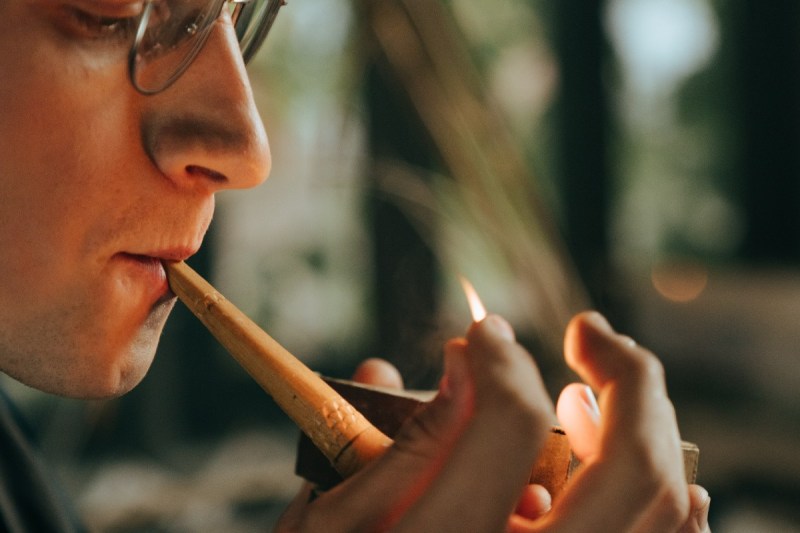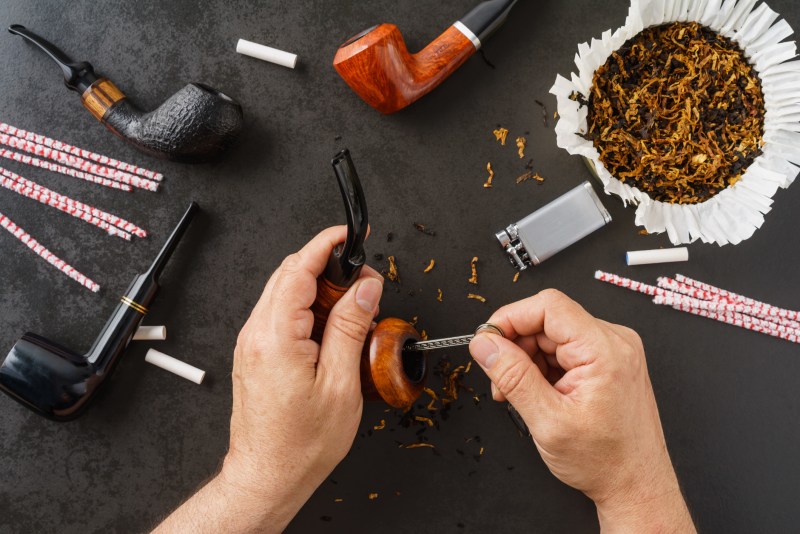Pipe smoking is the most aesthetically distinguished way to enjoy tobacco, but you lose the classy effect if you don’t know how to smoke a pipe properly. Smoking a pipe has become a lost art, and these days, most people who engage in pipe smoking do so to achieve a sense of nostalgia. Perhaps your grandfather enjoyed a puff now and again paired with a good stiff whiskey, or maybe your goal is to emulate a pipe-smoking artist. Whatever the case, if you intend to take up the time-honored tradition of unwinding with a pipe, you should learn how to smoke a pipe the right way.
There aren’t many tools required to smoke a pipe, but you do need these few essentials:
When considering your pipe-smoking inventory, there isn't one best set of tools. Much of it is personal preference, and yours may even change over time. Pipes come in all varieties, from basic corncob pipes to simple wooden pipes to highly ornate carved pieces that border on works of art. Choosing which one is right for you has more to do with personal aesthetic tastes than anything else.
Selecting the right tobacco also depends on your experience and your personal tastes. If you’re new to smoking pipe tobacco, a mild blend is best to ease into the pipe-smoking experience. Ask your local tobacconist for recommendations.
Likewise, lighters (or wooden matches) are a matter of personal preference too. While a traditional Bic will work, it’s not the best tool for getting a flame into the bowl of your pipe. Using wooden matches or long pipe lighters are the easiest ways to get the job done.
So, how do you smoke a pipe without looking like an amateur? As with most endeavors, it all starts with a little know-how. Here are all the accouterment, tips, and skills you'll need to kickstart your pipe-smoking journey.

How to smoke a pipe
Smoking is a leisurely activity in which you allow yourself time to slow down and enjoy the experience — unlike having a quick cigarette break at work. So carve out adequate time in your day to sit and enjoy a good pipe. Once you have set aside time to enjoy pipe smoking, follow these six steps to get started:
Step 1: Pack the bowl.
Fill the bowl with a loose pinch of tobacco, then press it down gently with the tamper. Fill it halfway. Top it off with another pinch, then tamp it down again. The bowl should be about two-thirds of the way full. Now add and tamp one more pinch of tobacco, leaving a tiny bit of space at the top of the bowl.
Step 2: Test draw.
Before lighting, give the pipe a few quick test puffs to make sure that air flows freely. If it doesn’t, repeat to step 1 and check your bowl. Consider repacking if necessary.
Step 3: Light up.
If you’re using matches, strike a match and allow a few seconds for the sulfur to burn off — otherwise, the sulfur will ruin the flavor of the tobacco. Apply the match or your pipe lighter flame to the bowl in a circular motion, drawing gently on the pipe at the same time. Usually, it will light first as a “false light.” Let this go out, then repeat the process again to achieve a “true light.”
Step 4: Puff, but don’t necessarily inhale.
Unlike smoking a cigarette, most people don’t inhale the smoke into their lungs when smoking a pipe. As with smoking a cigar, pipe tobacco tends to be rather strong, and the whole experience is about flavor. Enjoy taking little puffs of smoke into your mouth.
Step 5: Pace yourself.
Don’t smoke your pipe too fast, or else you may experience what pipe smokers call “tongue bite” — a burning, irritated sensation on the surface of your tongue. Puff slowly, and savor the richness and complexity of the tobacco. If your pipe goes, don’t worry. Relighting several times within a single smoking session is not uncommon.

Step 6: Clean out your pipe when finished.
After your session, tap or scrape out leftover tobacco from the bowl. Allowing your pipe to sit for too long can make it difficult to clean later. If your pipe makes a gurgling sound or sensation, moisture has built up in the stem, and your pipe will require deeper cleaning. Regular cleaning is also important for ensuring that the taste of the tobacco isn’t tainted.
Step 7: That's it! Now you know how to smoke a pipe like a gentleman.
Consider these pipe-smoking tips
These tips will have you smoking a pipe like a boss:
- Experiment with different tobaccos to find the one you like. If the first choice isn't to your liking, explore the wide range of tobacco blends available online or at your local smoke shop.
- If your tobacco is moist, allow it to dry slightly, as excessive moisture can lead to a hot vapor in the smoke, causing "tongue bite" (mentioned above).
- Avoid struggling to keep your pipe lit, as it only leads to frustration and potential burns. If the smoke tastes too hot, allow the pipe to cool down. If it goes out, tamp and relight, but take your time and be patient.
- Developing a cadence that keeps the pipe lit without overheating the smoke takes time and experience. Each pipe smoker's cadence is unique, so avoid comparing and focus on finding what works best for you.
- Remember, pipe smoking is about relaxation and savoring the moment.
Getting the most from your pipe-smoking experience is largely about your own personal experience. For some, pipe smoking is a great way to sit in solitude and reflect on the day in peace. For others, smoking a pipe is a social activity intended for good conversation. Whichever you choose, you now have another more sophisticated way to enjoy a good smoke.
Editors' Recommendations
- If you like Dune: Part Two, watch these epic sci-fi movies
- Forget rice: This is how to actually fix a wet iPhone, according to Apple
- Want to live in a tiny home? Here’s how much it would really cost, land and all
- A quick guide to Super Bowl prop bets and other fun football betting games
- Here’s how to watch the Super Bowl for free




